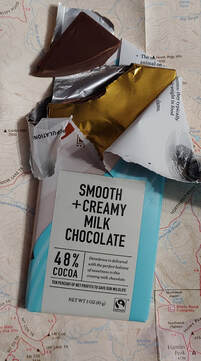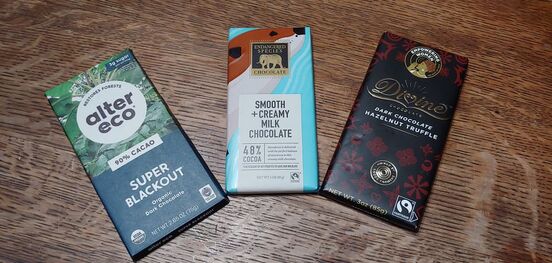Chocolate isn’t perishable and (unlike some brands of energy bar) won’t become an inedible chunk of concrete in freezing weather, but weather extremes can drastically affect chocolate, including its packability and taste. The typical chocolate bar is a mixture of cocoa solids and cocoa butter (both products of the tropical cacao plant) and some amount of sugar; other ingredients may include vegetable oils and milk solids. Chocolate bars also may contain other ingredients within or dressing the chocolate (nuts, dried fruit, encapsulated soft fillings like peanut butter, etc.). Dark chocolate contains a higher proportion of cocoa solids and a lower proportion of other ingredients; manufacturers of higher quality chocolate typically advertise the percentage of raw cocoa in their dark chocolate bars. The darker the chocolate, the more bitter the taste and the more caffeine per ounce. It’s the cocoa solids that contain the caffeine, and darker chocolates typically contain more cocoa solids and less cocoa butter. In milk chocolate, some cocoa is replaced with milk solids for a smoother taste and texture, and a lighter color. Other nut oils and pastes are sometimes used to smooth the texture of chocolate, creating a chocolate truffle-like texture (true chocolate truffle is a perishable food made with butter fats). White chocolate contains cocoa butter but no cocoa solids and it lacks the characteristic earthy taste and color typically associated with chocolate. Many cheap brands of chocolate—often the only kind you can purchase at convenience stores—contain a high amount of sugar and/or contain corn syrup derived sugars. Chocolate in Summer All chocolate will melt if exposed to enough heat (body heat, atmospheric heat, solar radiation, etc.). The melting point of a chocolate bar will vary (between 75°f and 90°f). Cocoa butter, vegetable oils, and milk lower the melting point of chocolate. Candy coating on chocolate may provide a little extra protection from melting (M&Ms etc.—but keep in mind that the typical M&M contains poorer quality milk chocolate, which melts at a lower temperature than dark chocolate). That being the case, darker chocolates and coated chocolates are a better choice in warmer weather, but even the darkest chocolate will melt on a hot summer day. To avoid the truly evil fate of a melted chocolate bar (“may the goo of a thousand chocolate bars stain your fleece!” is one of the vilest hiker curses ever uttered) it is wise to secure your chocolate in a zip-loc bag and then insulate it. You can insulate it by wrapping it in a jacket or sleeping bag and banishing it to the darkest recess of your pack where it may stay solid for a surprisingly long time (invariably, the idea of a sleeping bag or cold weather clothing insulating food from melting isn’t intuitive to some people—rest assured, as long as you are not wearing it, it’s insulating against heat gain and functioning no differently than a Styrofoam cooler—in a future article I’ll tell you how to pack a half gallon of ice cream up a trail in the summer using a sleeping bag). Let’s say your chocolate does melt and you’re jonesing for fix? If you secured it in a zip-loc (otherwise the only option is to lick it off your gear) and better yet have removed the paper and foil wrapper beforehand, you can harden it by submerging the bag in a running stream for maybe ten minutes or so—just don’t let the current carry the bag away! What about winter? While all chocolate bars pack well in winter, some people find that dark chocolate is less palatable when subject to freezing temperatures. The colder the temperature, the more the taste is dulled and the longer it takes for the chocolate to melt in your mouth. The effect can render the texture and flavor to something akin to confection-grade wax as the cocoa butter and cocoa solids become separated in your mouth instead of your gut. This blight is sometimes accompanied by the cocoa solids sticking unpleasantly to the roof of one’s mouth for an extended period. I’m not sure of the mechanism at play—it may have to do with the chemistry of cocoa. Other factors may include the proportion of cocoa butter (which melts) to cocoa solids (which don’t), the effect of a frozen chocolate bar on taste buds and the digestive enzymes in saliva, individual physiology and sense of taste, and (on particularly cold days) chill air being inhaled through the mouth as one eats. To avoid this fate, bring along milk chocolate, which is mostly immune to the winter curse, or pre-heat your dark chocolate by placing it in a warm pocket for a half-hour before you consume any of it. Lastly, it’s worth mentioning that chocolate containing nuts can add a little bit of nutritional balance and slow burn to what is otherwise a short term energy fix. Even better are foods containing bits of chocolate instead of the other way around. Eating too much sugary chocolate (or other sugars) can make you boink suddenly as the sugars are exhausted and your calorie load collapses. The caffeine in chocolate can also give you an artificial high—it may help with motivation but it isn’t a substitute for calories. So don’t be a boinker. Bon Appétit!
0 Comments
Leave a Reply. |
TOPICS
All
Humor (The Parsnip)

|
Proudly powered by Weebly


 RSS Feed
RSS Feed
